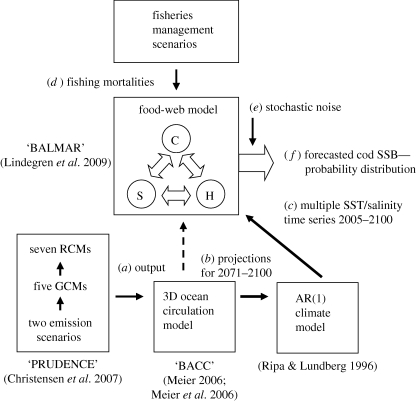Figure 1.
A coupled food web–climate model approach to forecasting Baltic cod stock dynamics in the twenty-first century. The BACC assessment uses a three dimensional (3D) ocean circulation model to explore the range of projected climate changes in the Baltic Sea region based on climate scenarios from the PRUDENCE ensemble model. The BACC assessment conducted ‘time-slice’ simulations for 2071–2100 but no transient time series are available. In order to facilitate coupling with the food-web model, an AR(1) climate model was used to simulate transient time series based on the future projections for each variable. Additionally, multiple simulations were run in order to represent the variability and uncertainty in climate forcing in the twenty-first century. Finally, the response of the cod stock to climate and fisheries management was studied by forcing the food-web model with fishing mortalities for cod (C) as well as for sprat (S) and herring (H). Cod stock dynamics are forecasted as a 95% probability distribution of future spawning stock biomass (SSB) by running multiple stochastic simulations including random noise. SST, sea surface temperature; RCM, regional climate model; GCM, global climate model; AR(1), first order autoregressive.

